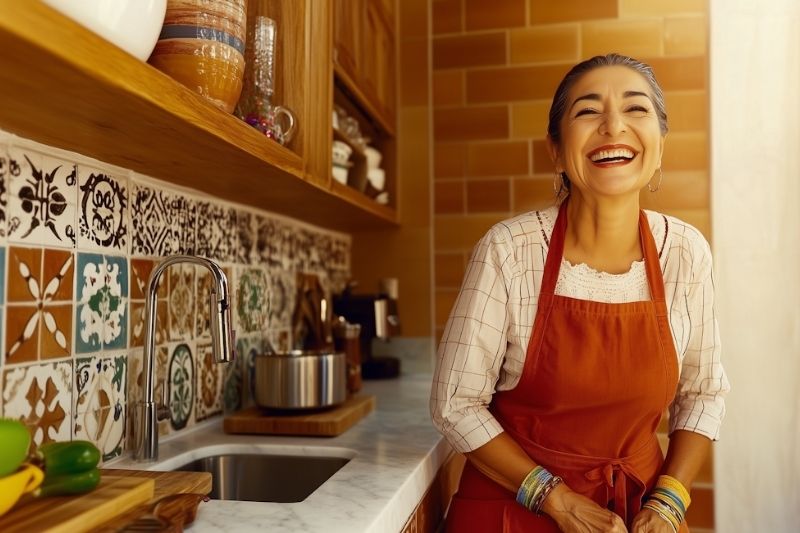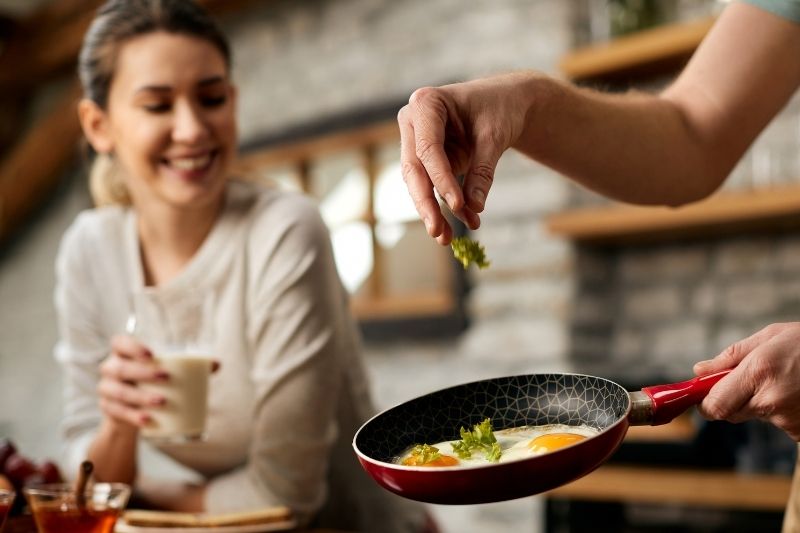There are things that travel with us without taking up space in the suitcase. The arepas, for example, sneak into every move, in every new beginning. They are that taste that we remember even before tasting it, the habit that accompanies us when everything else changes.
Upon arriving in another country, many of us discover that preparing arepas is a way to stay connected to our own. We make them to share, for ourselves, or simply to feel a little closer to home. In that mixture of flour, water and memory there is more than just a recipe: there are membershipthere are memory and, above all, there are continuity.
Because even though borders separate us, we continue to find ways of being. And sometimes, all it takes is one arepa hot on the table to remind us that, wherever we are, we are still the same: the ones we care for, the ones we support and the ones who still belong to our home.
Where arepas come from

Long before they became a part of the daily lives of those who we migratethe arepas were already traveling throughout the American continent.
Its history begins more than three thousand years ago, when the original peoples of the regions that today are Venezuela y Colombia prepared flat breads made of ground corn to accompany their meals.
The word arepa comes from the indigenous word “erepa”, which in the Cumanagota language (a people from eastern Venezuela) means precisely corn. It was a simple meal, but essential, a way to take advantage of the cereal that sustained its food supply.
Over time, the arepas went from being an ancestral food to become a daily tradition. In each region they were given a different shape, thicker, thinner, sweet or salty, but always with the same principle: to prepare with the hands something that unites.
During the last century XX, the invention of the corn flour precooked allowed the arepas and quicker to prepare, which led them to conquer kitchens all over the world. Latin America.
And when millions of people began to emigrate, corn traveled with them: in bags, in memories, in stories told through flavor.
Today, in cities such as Miami, New York or Houstonit is possible to find arepas on almost every corner. What began in the indigenous hearths of the Caribbean and the Andes became a global symbol of Latin identity.
A ancient recipe that is still alive because, in its simplicity, it holds something that we all recognize: home, regardless of the map.
When migrating tastes like arepa

“My grandmother used to say that to knead was to put thoughts in order. And she was right, between flour and corn, everything comes back to its place.”
Migrate has many flavors, and one of them, perhaps the most comforting, is that of habit. In the midst of new schedules, different jobs and streets that we have not yet learned to name, meeting again with the arepas is a simple way to feel safe.
It happens to many of us. We arrive with the desire to start, to send our first shipment, In the midst of the accelerated pace of this country, one morning we decide to knead. Making them becomes a ritual that commands us: a pause that smells like corn, home, to calm.
The arepas not only feed, they also bring people together. They are prepared in shared kitchens, in small apartments or in improvised patios, where laughter, accents and the desire to continue.
And even though we are far away, every time we make them we return, even if only for a moment, to that place where it all began. Because they are not just food: they are presence, memory and a way of saying, without words, that we are still here, taking care of what is ours from another shore.
Cooking your own to stay connected

When we arrive in a new country, we are not only looking for work, we are looking for rhythm, for familiar words, for someone who understands how it feels to start from scratch.
Sometimes, that meeting point arrives with the smell of roasted corn. In many neighborhoods of United Statesthe arepas have created communities as real as the ones we leave behind.
What starts in a small kitchen ends up being a shared space, in a garage turned retail outlet, a local fair that smells like hot dough, a table where accents and memories mingle.
The arepas thus become a kind of common language. No matter what country we come from, we all recognize something familiar in them. They are easy to prepare, they adapt to what is in the most popular supermarkets, The food, corn flour, cheese, avocado, (whatever we can find), and they always invite you to stay a little longer.
In this sharing, friendships are made, doors are opened and an invisible network of support is generated. It's not just food: it's economy, company, apprenticeship.
The arepas become a symbol of creativity and community. They remind us that, even far away, we are still able to create home with what we have at hand.
Recipe and types of arepas: a tradition that adapts without losing its flavor
In any city of United States Wherever there is a Latino community, the smell of a hot griddle is almost certain to announce the same: arepas freshly made.
Although each family has its own particular way of preparing them, the basis remains the same: precooked corn flour, water, salt and, sometimes, a bit of oil or butter.
We knead, form discs and bake them in budare, frying pan o iron until golden brown on the outside and soft on the inside. Then, everyone gives it their own touch.
With the passage of time, the arepas have been adapted to the ingredients available in United Statessome are made with whole wheat flour, others with American cheese or with local vegetables. But, in essence, they remain the same: round, versatile and always open to whatever is at hand.
The following is a tour of the best known and most beloved types of this tradition that travels without a passport:
Venezuelan Arepas
The best known outside Latin America. They are thick, spongy and are cut in half for filling.
- Queen Pepiada: with chicken, mayonnaise and avocado.
- Pavilion: with carne mechada, black beans and ripe plantains.
- Dominoes: with beans and grated white cheese.
- Pelúa: with shredded meat and yellow cheese.
- Catira: with chicken and grated cheese.
- Perico: stuffed with scrambled egg with onion and tomato.
- Cheese arepa: the dough is mixed with fresh cheese so that it melts inside.
- Fried Arepa: browned in oil until crispy.
- Andean Arepa: made with wheat flour, typical of the mountainous region of Venezuela.
- Arepa tumbarrancho: pride of Maracaibo, is a fried and battered version, like a kind of tempura criolla, which is then stuffed with mortadella, cheese, cabbage, tomato and sauces.
Colombian Arepas
Generally thinner and with great regional variety. Some are served alone, others accompany breakfast or dinner.
- Corn Arepa: sweet and soft, made with tender corn and melted cheese on top.
- Paisa Arepa: thin, white and lightly toasted, a staple of the Antioquian breakfast.
- Arepa boyacense: with cheese and a touch of sugar, cooked in the oven or on a griddle.
- Arepa santandereana: with ground chicharrón and yucca.
- Egg Arepa: stuffed with fried egg, typical of the Caribbean coast.
- Arepa valluna: larger and simpler, it usually accompanies meats or soups.
Modern and regional variations
The migration and creativity have given rise to new versions in United States and other countries:
- Arepas with oatmeal or whole wheat flour, lighter.
- Vegan Arepas, with tofu, bean or roasted vegetable fillings.
- Mini arepas for picadas and events.
- Sweet Arepas, with honey or papelón.
- Stuffed breakfast arepas, with eggs, bacon or avocado.
- Gluten free arepas, made with alternative natural corn flours.
The flavor we carry with us

In every city where there is someone who came from far away, sooner or later a hot griddle and the familiar sound of browning dough appear. The arepas are no longer just a memory of the country we left: they are a way of inhabiting the present, of creating something of our own in the place where we are.
They can be found in small family-run businesses, at neighborhood fairs, in food trucks that travel the streets of the city, and in the streets of Miami or New York.
Sometimes, they are prepared by a mother who wants to teach your children where he comes from; others, a young man who decided to start a business in order to get ahead. In all cases, behind each arepa there is a history of proofof adaptation and of sweetheart for its own sake.
Because we continue to share more than just food from afar: we share identity. The arepas remind us that, even though we are miles away, we carry our culture in our hands, in our hearts, in our minds. aroma of the kitchen, in the way we gather around a simple dish.
And so, among flour y corn, we discover that belonging is not to stay in one place: it is to continue to take care of who we are, wherever we are.
As long as there are arepas, Even if the map changes, even if everything else is new, this way of being together, of supporting each other and recognizing each other will continue to exist.
At Curiara, we believe that there are many ways to care from afar. Sometimes it is a international transfer that arrives on time; others, a phone call or a recipe shared via video call.
Every gesture, big or small, is a way of saying “I am still with you”. Just like the arepas cross borders without losing their flavor, so does caring. Because caring is also a way of being. And in every story, in every shipment, in every arepa, we continue to move forward together.
